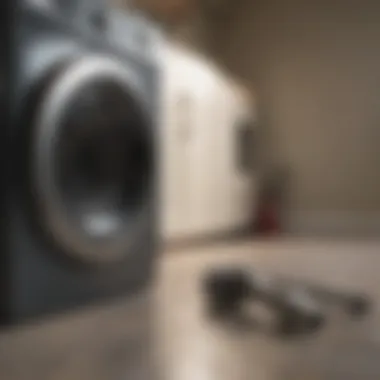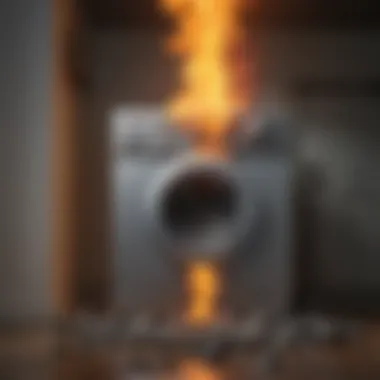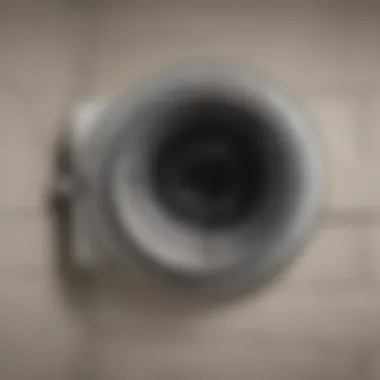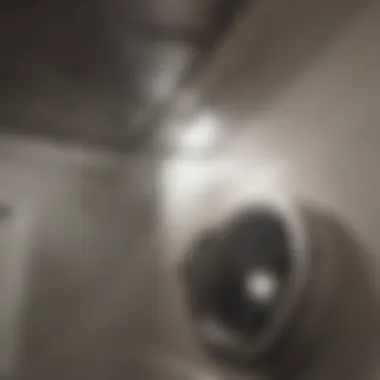Mastering Dryer Vent Cleaning for Home Safety


Intro
Regular dryer vent cleaning is vital for maintaining both the efficiency of the appliance and the safety of your home. Clogged dryer vents can lead to extended drying times, increased energy costs, and even fire hazards due to lint build-up. Understanding the importance of keeping vents clean is crucial, not just for homeowners, but also for real estate enthusiasts and interior decorators who value safety as much as aesthetics. This article will guide you through the essential practices and tools needed to effectively clean your dryer vents, highlighting the potential risks associated with neglect and outlining effective maintenance schedules.
The Importance of Dryer Vent Cleaning
Effective dryer vent cleaning goes beyond mere aesthetics and convenience. Here’s why it should be a priority:
- Preventing Fires: Approximately 2,900 home fires each year result from clothes dryers, according to the National Fire Protection Association. Lint is highly flammable, making frequent cleaning a critical safety measure.
- Energy Efficiency: Clogged vents cause dryers to work harder, resulting in higher energy consumption. A clean vent minimizes energy costs and prolongs the dryer’s life span.
- Enhanced Dryer Performance: Regularly maintaining the vent ensures that clothes dry more completely and in less time, maximizing convenience for users.
"Neglecting to clean dryer vents can lead not only to fires but also to costly repairs and inefficient energy use."
Tools and Techniques for Cleaning
To achieve optimal results in dryer vent cleaning, a variety of tools and methods should be employed. Here is a concise list of recommended items and techniques:
Recommended Tools
- Dryer Vent Cleaning Kit: These kits often include brushes that can reach deep within the vent.
- Vacuum Cleaner with Hose Attachment: Essential for removing debris from the system.
- Flexible Rods: Useful for accessing hard-to-reach areas in the vent.
- Safety Gear: Gloves and a dust mask are recommended to protect against lint inhalation.
Step-by-Step Cleaning Process
- Disconnect the Dryer: Start by unplugging the dryer and moving it away from the wall to access the vent.
- Inspect the Vent: Check for visible lint accumulation at the exit and along the vent pathway.
- Brush the Vent: Use a cleaning brush from the dryer vent cleaning kit, moving it in and out to loosen any clogs.
- Vacuum the Debris: After loosening the lint, use a vacuum to remove the debris.
- Reassemble and Test: Reconnect the dryer, plug it in, and run a test cycle to ensure everything is functioning properly.
Maintenance Tips
To maintain the efficiency of dryer vent systems, consider implementing a maintenance routine. The following suggestions can help ensure your vents remain clear:
- Frequency of Cleaning: It�’s best to clean vents at least once every six months, with increased frequency for heavy users.
- Professional Inspections: Consider hiring a professional service annually to conduct a thorough inspection and cleaning.
- Monitor Performance: Be attuned to changes in drying time, which can indicate a buildup in the vent system.
Prelims to Dryer Vent Maintenance
Dryer vent maintenance is an essential component of home safety and efficiency. Many homeowners underestimate the importance of taking care of their dryer vents. However, regular maintenance directly impacts not only the lifespan of the appliance but also household safety. Clogged dryer vents can cause dangerous fires and lead to increased energy consumption. In this section, we will delve into the workings of dryer vent systems and the necessity of their upkeep.
Understanding Dryer Vent Systems
Dryer vent systems play a critical role in removing moisture and lint generated during the drying process. Air is circulated through a duct connected to the dryer, venting outside to maintain optimal operation. Typically, these systems consist of several components, including the dryer's exhaust, ducting, and the external vent cap.
Each of these parts must work together efficiently for proper ventilation. However, over time, lint can accumulate and obstruct airflow. This blockage not only reduces drying efficiency but also heightens the risk of fire hazards significantly. Homeowners must understand that their dryer vent system needs regular inspection and cleaning to function correctly.
Importance of Regular Cleaning
Cleaning dryer vents regularly is crucial to ensure safety and efficiency. Here are a few benefits associated with routine maintenance:
- Fire Prevention: Lint buildup in the vents is highly flammable, which makes it a primary fire hazard. According to the National Fire Protection Association, failure to clean dryer vents is a leading cause of home dryer fires.
- Improved Efficiency: A clean vent allows for better airflow, resulting in shorter drying times. This efficiency can lead to lower energy bills as the dryer will not have to work as hard to dry clothes.
- Extended Appliance Life: Regular cleaning minimizes strain on the dryer, which can prolong its life, reducing costly repair and replacement needs.
"Routine cleaning of dryer vents can reduce fire risk by up to 40%" – Safety experts recommend engaging in a cleaning schedule.
By embracing a consistent approach to dryer vent maintenance, homeowners can protect their property, save on energy costs, and extend the longevity of their appliances.
Safety Risks Associated with Clogged Vents
Maintaining a clean dryer vent is not merely a routine task; it is an essential measure that addresses serious safety concerns linked to the accumulation of lint and debris. Clogged dryer vents pose significant risks not only to the efficiency of the appliance but also to the safety of the home and its occupants. Residential fires can originate from blocked vents, making awareness of these risks critical for homeowners, real estate enthusiasts, and interior decorators alike.


Fire Hazards and Statistics
According to the U.S. Fire Administration, nearly 3,000 home fires are reported each year due to clothing dryers. These fires can cause severe damage to property and can, unfortunately, lead to loss of life. The leading cause? Clogged dryer vents. With the buildup of lint, a highly flammable material, these obstructions prevent hot air from escaping, creating an environment where fires can ignite easily.
- Statistics from the U.S. Fire Administration indicate that:
- 34% of dryer fires are caused by failure to clean the dryer vent.
- Lint buildup ignites in cases where ventilation is obstructed.
- Approximately 85% of fires occur in residential structures.
As these facts demonstrate, neglecting dryer vent cleaning is not just an inconvenience; it is a matter of safety that can have devastating consequences. Homeowners should regularly inspect and clean their dryer vents to mitigate these risks.
Efficiency Loss and Increased Energy Costs
Clogged vents do not only present fire hazards but also affect the efficiency of the dryer. As lint accumulates within the vent system, the dryer has to work harder and uses more energy to dry clothes effectively. This increased workload translates into longer drying times, which results in higher energy bills.
In fact, research suggests that homeowners can save up to 30% on energy costs by keeping dryer vents clean. More specifically, here are a couple of indicators of efficiency loss:
- Clothes take longer to dry when vents are clogged.
- Excessive heat may emit from the dryer during operation, indicating a waning performance.
A comprehensive approach to maintaining dryer vent cleanliness not only enhances safety but also delivers significant energy savings.
"Regular maintenance of dryer vents can lead to higher energy efficiency. Never overlook this aspect of home care."
In summary, the safety risks associated with clogged dryer vents are serious and multifaceted, involving both the threat of fire and increased energy costs. Homeowners should prioritize this maintenance task to ensure both their safety and improved energy efficiency.
Tools Required for Effective Cleaning
When it comes to dryer vent cleaning, having the right tools is crucial. The effectiveness of the cleaning process heavily relies on the equipment used. Each tool serves a specific purpose that contributes to removing lint, debris, and blockages that can inhibit performance and create hazards. Choosing appropriate tools not only enhances cleaning results but also ensures the safety of the individual performing the task. Ignoring the importance of the right tools can lead to incomplete cleaning and risk of fire hazards.
Basic Cleaning Tools
Basic cleaning tools are foundational for anyone looking to maintain their dryer vent systems adequately. These tools are often affordable and easy to find, making them accessible for most homeowners. Common tools include:
- Lint Brush: This tool is essential for manually removing lint from accessible areas of the vent. Its long handle helps reach deep into ducts.
- Vacuum Cleaner: A vacuum equipped with a hose attachment is useful for sucking out lint and debris from the vent system. Ensure it has strong suction capability.
- Flexible Duct Cleaning Brush: This tool can navigate the bends and curves in ductwork. It usually has a long handle and bristles that help dislodge stubborn lint.
Using these basic tools can significantly improve dryer efficiency and reduce the risk of hazards.
Advanced Cleaning Equipment
While basic cleaning tools can handle surface-level issues, advanced equipment offers a deeper clean and greater effectiveness. These tools are typically reserved for more thorough tasks or for professional cleaners. Common advanced tools include:
- Electric Duct Cleaning System: This machine uses rotary brushes to clean the ductwork thoroughly, removing buildup of lint and other debris. It is particularly useful for long ducts.
- Compressed Air Blower: This machine can push out lint and debris that may be stuck in tight corners. It is particularly effective when paired with a vacuum.
- Inspection Cameras: Such devices allow the user to inspect the inside of the vent after cleaning to ensure it is fully cleared. They can reveal areas that need more attention.
The investment in advanced cleaning equipment can be worthwhile for those who require regular deep cleaning or who have high-efficiency dryers.
Safety Gear for Technicians
Safety should always be a priority during dryer vent cleaning, particularly for professionals who may frequently engage in this work. Certain protective gear not only safeguards against physical injuries but also limits exposure to harmful dust and debris. Essential safety gear includes:
- Gloves: Wearing gloves protects hands from sharp objects hidden in the vent and also keeps hands clean from lint and debris.
- Safety Goggles: These prevent debris from entering the eyes during cleaning. Lint can pose an irritating hazard, especially in large quantities.
- Dust Masks: It is crucial to wear a mask to protect from inhaling lint particles and dust. This gear is particularly important during extensive cleaning where debris may be disturbed.
Proper safety equipment not only enhances personal safety but also makes the cleaning process more efficient, allowing technicians to focus on the task without worry.
Effective dryer vent cleaning requires skill, the right tools, and safety precautions to achieve optimal results and prevent hazards.


Step-by-Step Guide to Cleaning Dryer Vents
Cleaning dryer vents is essential not only for efficiency but also for safety. This step-by-step guide thoroughly outlines the methods and processes involved in effective dryer vent cleaning. Understanding these methods helps homeowners maintain optimal dryer performance while minimizing fire hazards. This guide will enable readers to approach dryer vent maintenance with confidence and assurance, facilitating regular upkeep and awareness of potential issues.
Preparation: Gathering Tools and Supplies
Before starting the cleaning process, it is crucial to gather the right tools and supplies. Being prepared ensures that the cleaning goes smoothly and efficiently. Key tools include:
- Lint brush: This is specifically designed to remove lint from ducts and vents.
- Vacuum cleaner: A vacuum with a long hose attachment can effectively eliminate debris.
- Screwdriver: Necessary for removing duct covers and securing them back in place.
- Cleaning rods: These flexible rods help reach into the ductwork for thorough cleaning.
Having these items on hand prevents delays and makes the entire process more effective. It's advisable to have a designated area to house these cleaning supplies to ensure quick access in the future.
Disconnecting Your Dryer: Safety First
Prior to cleaning, ensure the dryer is disconnected to avoid any accidents. Safety is the top priority when performing maintenance tasks. Begin by unplugging the dryer from the electrical outlet. If your dryer is gas-powered, make sure to turn off the gas supply. This step is essential as it protects the user from electrical shocks and potential gas leaks during the cleaning process.
Once disconnected, consider moving the dryer away from the wall to gain better access to the venting system. This space will allow you to efficiently work on the duct without feeling cramped or rushed. Always remember that safety equipment, such as gloves and protective eyewear, should be worn when cleaning.
Cleaning the Vent Duct
With the dryer safely disconnected, it is time to begin cleaning the vent duct. Start by removing the duct clamps and detaching the vent from the dryer. Using the lint brush, gently scrub the inside of the duct. This method will help dislodge built-up lint that may not be visible.
Next, insert the vacuum hose into the duct to capture any loose debris. If using cleaning rods, attach them to the lint brush and push them through the duct. Rotate them to ensure a thorough clean. It's critical to reach deep into the vent, as lint can accumulate significantly out of sight, affecting airflow and dryer efficiency.
Inspecting the Venting System
After cleaning, inspect the venting system for any damage or signs of wear. Look for any kinks or bends in the duct that might restrict airflow. Also, check the vent cap on the exterior of the home for blockage or damage. Ensure that it opens easily and no debris obstructs it.
This inspection is an integral part of the cleaning process—catching problems early can save homeowners from costly repairs later. If any issues are discovered, consider filing them away for future repairs.
Reassembling and Testing the Dryer
Once cleaning and inspections are complete, reassemble all components of the dryer and the vent system. Securely reattach the duct with clamps, making sure everything fits well. Check all connections to ensure a tight seal to prevent further lint build-up in the future.
Finally, plug the dryer back in or turn the gas supply on if applicable. Run a short dry cycle with a damp towel inside. This test will allow you to confirm that the dryer is functioning correctly, and airflow is restored to optimal levels. Proper airflow is essential for efficiency and safety, so monitor performance over the next few uses. If any issues arise, revisiting the cleaning process or contacting a professional may be necessary.
Using these steps ensures that dryer vent maintenance is done safely and effectively, preserving the life of the appliance and promoting home safety.
Indicators of Poor Vent Performance
Recognizing the signs of poor dryer vent performance is crucial for maintaining the efficiency and safety of your drying system. Effective dryer vent cleaning is not only about routine maintenance; understanding the indicators of inefficiency can prevent potential hazards and save energy. Knowing what to look for can lead to timely interventions, ensuring your dryer operates effectively while minimizing risks associated with excessive lint buildup.
Long Drying Times
One significant sign of ineffective venting is extended drying times. If your clothes do not dry within the usual cycle and require additional time, it may indicate a blockage in the vent system. The accumulated lint or debris restricts airflow, preventing moisture from escaping. Thus, the dryer works harder, leading to increased wear and energy consumption.
It is advisable to monitor drying times regularly. If you notice they are increasing, check the vent for clogs or obstructions. Continued reliance on an underperforming dryer can result in higher utility costs and unnecessary strain on the appliance.
Excessive Heat Emission
Another clear indication of poor vent performance is noticeable heat emission from the dryer. If the exterior surface of your dryer feels unusually warm during operation, this is a warning sign. Excessive heat usually stems from poor airflow caused by lint buildup or a blocked vent
Continued operation under these conditions can pose fire risks. Lint is highly flammable and can ignite if it overheats. It is essential to address this issue promptly by inspecting and cleaning the vents, ensuring proper airflow and reducing heat buildup.


Lint Backup Visible in the Vent Outlet
Lastly, observe for any visible lint backups at the vent outlet. If lint can be seen or if your dryer vent has become clogged enough to prevent proper exhaust, this is a definitive cue that cleaning is necessary. This buildup signifies the likelihood of a larger obstruction within the vent system.
Addressing this issue not only improves dryer efficiency but also reduces the risk of hazardous situations, including fires. Regular checks at the vent outlet can help identify problems before they worsen, ensuring safe and effective operation of your dryer.
"The best way to avoid the risks associated with clogged dryer vents is to remain vigilant about their performance and act accordingly."
Professional Dryer Vent Cleaning Services
Maintaining a dryer vent is a task that can often be overlooked by homeowners. However, understanding the significance of professional dryer vent cleaning services can transform a mundane chore into a pivotal aspect of home safety and efficiency. Hiring professionals can help ensure that cleaning is both thorough and effective.
Professional services bring expertise and specialized tools that the average homeowner may not possess. They are trained to identify and eliminate blockages that are not readily visible. Such expertise is crucial, especially when dealing with complex vent systems. Moreover, a comprehensive cleaning can prevent the many risks associated with clogged dryer vents, including fire hazards and damage to the dryer itself.
When to Consider Professional Assistance
There are specific situations when professional assistance becomes essential for dryer vent cleaning. Recognizing these instances can help you avoid potential hazards and prolong the life of your appliance.
- Frequent Clogging: If you find yourself cleaning the lint trap frequently or experiencing regular backups, this signals a more serious problem within the vent.
- Increased Drying Times: A noticeable increase in the time it takes to dry clothes can indicate that the vent is not functioning properly. If clothes are still damp after a full cycle, it might be time to call in experts.
- Strong Odors: A musty smell or the detection of heat near the dryer can mean that lint is building up in the duct, requiring immediate attention.
- Older Vents: Homes with older dryer vent systems or those that use flexible ducting might not have the airflow capability of newer systems. Professional cleaning can enhance their efficiency.
Choosing a Qualified Service Provider
Selecting the right service provider for dryer vent cleaning involves certain considerations that ensure you make an informed choice. It is crucial to find a qualified professional who can meet your specific needs.
- Certification and Experience: Look for certified professionals who have experience with dryer vent cleaning. Check their credentials and ask about their training.
- Recommendations and Reviews: Seek recommendations from friends or family or look for online reviews about potential service providers. Reputable companies will often have testimonials detailing their services.
- Services Offered: Ensure the provider offers comprehensive services, including inspection, cleaning, and maintenance plans. It’s important to select a service that will do more than just a superficial job.
- Insurance: Confirm that the company carries liability insurance. This protects you should any damage occur during the service.
Preventative Measures for Dryer Vent Maintenance
Preventative measures are crucial for ensuring the longevity and efficiency of dryer vent systems. Regular maintenance not only minimizes the risk of hazardous situations but also promotes optimal performance. Homeowners should recognize that neglecting dryer vent cleaning can lead to numerous problems, including increased energy costs and potential fire hazards. By implementing preventative strategies, individuals can save time and expenses associated with repairs and cleaning.
Regular Cleaning Schedule Recommendations
To maintain the efficiency of dryer vent systems, it's recommended to establish a regular cleaning schedule. The frequency can depend on several factors:
- Usage: If the dryer is used frequently for large loads, cleaning should be done every four to six months.
- Type of Dryer: Different dryers may have varying efficiency levels. Consider cleaning every three to four months for older, less efficient models.
- Household Size: A larger family typically generates more lint. A cleaning interval of three to four months can be beneficial.
Creating a calendar reminder can help ensure regular maintenance. Additionally, homeowners might consider seasonal cleaning during spring and fall when other household tasks are often being addressed. This proactive approach can prevent declined performance and potential hazards related to clogged vents.
Educating Household Members
It is essential that all members of the household understand the importance of dryer vent maintenance. Education can empower everyone to contribute to the process. Here are some effective strategies:
- Share Knowledge: Hold a discussion about the risks associated with clogged vents. Explain how lint buildup can lead to fires and inefficiencies.
- Demonstrate Proper Usage: Show how to clean the lint trap before every dryer use and encourage everyone to do so. Stress the importance of not overloading the dryer, as this can contribute to poor air circulation.
- Visual Guides: Create simple checklists or posters that outline what to look for regarding dryer performance indicators or when to report issues. This can help ensure everyone is vigilant.
By educating household members about dryer vent care, you not only enhance safety but also foster a culture of shared responsibility. This creates a practical approach to maintaining an effective system that benefits the entire household.
End and Summary
Effective dryer vent cleaning is crucial for maintaining the safety and efficiency of your home’s dryer system. Overlooking the cleaning of dryer vents can lead to several hazards, including fire risks and increased energy costs. As discussed throughout this article, a systematic approach to dryer vent maintenance not only prolongs the life of the appliance but also ensures its optimal performance. By understanding why regular maintenance is important, homeowners can prevent the serious complications that come with neglected vents.
Recap of Key Points
- Understanding dryer vent systems is fundamental for effective maintenance. These systems guide the airflow and moisture away from the dryer, preventing buildups of lint and debris.
- Regular cleaning is essential, as it reduces the risk of fire due to lint accumulation and improves dryer efficiency, leading to lower energy bills.
- Essential tools and techniques were outlined to equip readers for preventative care or effective cleaning. Using the correct tools can simplify the cleaning process greatly.
- The indicators of poor vent performance provide critical insights into when action is needed. Recognizing these signs early can prevent further complications and costly repairs.
- The section on professional services addressed when hiring an expert is advisable and how to choose a qualified provider.
- Lastly, understanding preventative measures provides ongoing strategies for maintaining vent cleanliness and safety.
Final Thoughts on Dryer Vent Care
In summary, dryer vent care should be a fundamental aspect of home maintenance. Homeowners, real estate enthusiasts, and design aficionados alike benefit from incorporating a cleaning schedule into their routine. This proactive approach prevents serious issues and enhances efficiency.
Adopting best practices ensures that your dryer operates effectively and safely. This is especially crucial in homes where frequent use leads to higher risks of lint buildup. Given the simplicity of implementing these measures, it is both an effective and smart investment in one's home.
Regularly scheduled maintenance is not just a chore; it is a safeguard against potential hazards that could disrupt your home and lifestyle.















